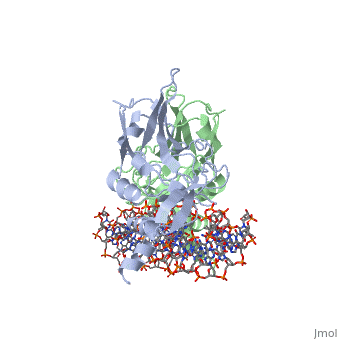1xbr: Difference between revisions
No edit summary |
No edit summary |
||
| Line 1: | Line 1: | ||
==T DOMAIN FROM XENOPUS LAEVIS BOUND TO DNA== | ==T DOMAIN FROM XENOPUS LAEVIS BOUND TO DNA== | ||
<StructureSection load='1xbr' size='340' side='right' caption='[[1xbr]], [[Resolution|resolution]] 2.50Å' scene=''> | <StructureSection load='1xbr' size='340' side='right'caption='[[1xbr]], [[Resolution|resolution]] 2.50Å' scene=''> | ||
== Structural highlights == | == Structural highlights == | ||
<table><tr><td colspan='2'>[[1xbr]] is a 4 chain structure with sequence from [http://en.wikipedia.org/wiki/ ] and [http://en.wikipedia.org/wiki/African_clawed_frog African clawed frog]. Full crystallographic information is available from [http://oca.weizmann.ac.il/oca-bin/ocashort?id=1XBR OCA]. For a <b>guided tour on the structure components</b> use [http:// | <table><tr><td colspan='2'>[[1xbr]] is a 4 chain structure with sequence from [http://en.wikipedia.org/wiki/ ] and [http://en.wikipedia.org/wiki/African_clawed_frog African clawed frog]. Full crystallographic information is available from [http://oca.weizmann.ac.il/oca-bin/ocashort?id=1XBR OCA]. For a <b>guided tour on the structure components</b> use [http://proteopedia.org/fgij/fg.htm?mol=1XBR FirstGlance]. <br> | ||
</td></tr><tr id='gene'><td class="sblockLbl"><b>[[Gene|Gene:]]</b></td><td class="sblockDat">XBRA ([http://www.ncbi.nlm.nih.gov/Taxonomy/Browser/wwwtax.cgi?mode=Info&srchmode=5&id=8355 African clawed frog])</td></tr> | </td></tr><tr id='gene'><td class="sblockLbl"><b>[[Gene|Gene:]]</b></td><td class="sblockDat">XBRA ([http://www.ncbi.nlm.nih.gov/Taxonomy/Browser/wwwtax.cgi?mode=Info&srchmode=5&id=8355 African clawed frog])</td></tr> | ||
<tr id='resources'><td class="sblockLbl"><b>Resources:</b></td><td class="sblockDat"><span class='plainlinks'>[http:// | <tr id='resources'><td class="sblockLbl"><b>Resources:</b></td><td class="sblockDat"><span class='plainlinks'>[http://proteopedia.org/fgij/fg.htm?mol=1xbr FirstGlance], [http://oca.weizmann.ac.il/oca-bin/ocaids?id=1xbr OCA], [http://pdbe.org/1xbr PDBe], [http://www.rcsb.org/pdb/explore.do?structureId=1xbr RCSB], [http://www.ebi.ac.uk/pdbsum/1xbr PDBsum], [http://prosat.h-its.org/prosat/prosatexe?pdbcode=1xbr ProSAT]</span></td></tr> | ||
</table> | </table> | ||
== Function == | == Function == | ||
| Line 36: | Line 36: | ||
</StructureSection> | </StructureSection> | ||
[[Category: African clawed frog]] | [[Category: African clawed frog]] | ||
[[Category: Large Structures]] | |||
[[Category: Muller, C W]] | [[Category: Muller, C W]] | ||
[[Category: Dna-binding protein]] | [[Category: Dna-binding protein]] | ||
[[Category: Transcription factor]] | [[Category: Transcription factor]] | ||
[[Category: Transcription-dna complex]] | [[Category: Transcription-dna complex]] | ||
Revision as of 12:52, 6 January 2021
T DOMAIN FROM XENOPUS LAEVIS BOUND TO DNAT DOMAIN FROM XENOPUS LAEVIS BOUND TO DNA
Structural highlights
Function[BRAC_XENLA] Involved in the transcriptional regulation of genes required for mesoderm formation and differentiation. Causes dorsal mesodermal differentiation of animal cap ectoderm when co-expressed with wnt8 and noggin. None of these molecules causes dorsal mesoderm formation when expressed alone. Establishes the left/right axis at early gastrula stage by directly up-regulating mesodermal expression of zic3.[1] [2] Evolutionary Conservation Check, as determined by ConSurfDB. You may read the explanation of the method and the full data available from ConSurf. Publication Abstract from PubMedThe mouse Brachyury (T) gene is the prototype of a growing family of so-called T-box genes which encode transcriptional regulators and have been identified in a variety of invertebrates and vertebrates, including humans. Mutations in Brachyury and other T-box genes result in drastic embryonic phenotypes, indicating that T-box gene products are essential in tissue specification, morphogenesis and organogenesis. The T-box encodes a DNA-binding domain of about 180 amino-acid residues, the T domain. Here we report the X-ray structure of the T domain from Xenopus laevis in complex with a 24-nucleotide palindromic DNA duplex. We show that the protein is bound as a dimer, interacting with the major and the minor grooves of the DNA. A new type of specific DNA contact is seen, in which a carboxy-terminal helix is deeply embedded into an enlarged minor groove without bending the DNA. Hydrophobic interactions and an unusual main-chain carbonyl contact to a guanine account for sequence-specific recognition in the minor groove by this helix. Thus the structure of this T domain complex with DNA reveals a new way in which a protein can recognize DNA. Crystallographic structure of the T domain-DNA complex of the Brachyury transcription factor.,Muller CW, Herrmann BG Nature. 1997 Oct 23;389(6653):884-8. PMID:9349824[3] From MEDLINE®/PubMed®, a database of the U.S. National Library of Medicine. See AlsoReferences
|
| ||||||||||||||||
